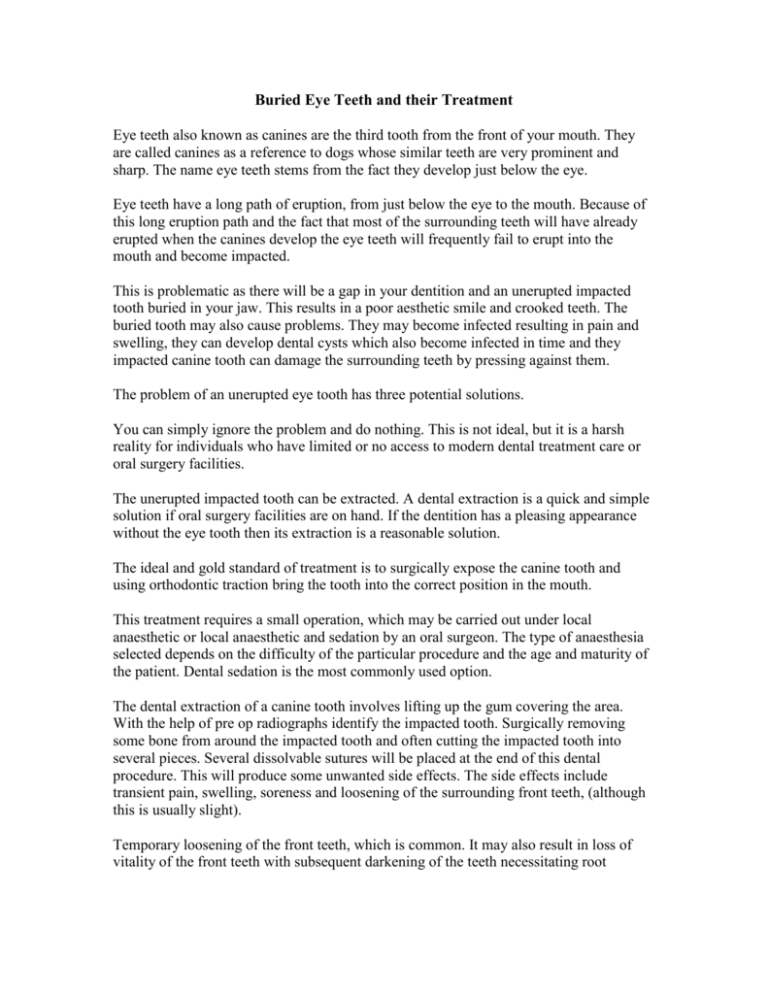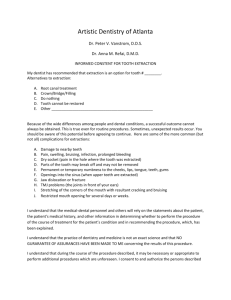operations-on-eye
advertisement

Buried Eye Teeth and their Treatment Eye teeth also known as canines are the third tooth from the front of your mouth. They are called canines as a reference to dogs whose similar teeth are very prominent and sharp. The name eye teeth stems from the fact they develop just below the eye. Eye teeth have a long path of eruption, from just below the eye to the mouth. Because of this long eruption path and the fact that most of the surrounding teeth will have already erupted when the canines develop the eye teeth will frequently fail to erupt into the mouth and become impacted. This is problematic as there will be a gap in your dentition and an unerupted impacted tooth buried in your jaw. This results in a poor aesthetic smile and crooked teeth. The buried tooth may also cause problems. They may become infected resulting in pain and swelling, they can develop dental cysts which also become infected in time and they impacted canine tooth can damage the surrounding teeth by pressing against them. The problem of an unerupted eye tooth has three potential solutions. You can simply ignore the problem and do nothing. This is not ideal, but it is a harsh reality for individuals who have limited or no access to modern dental treatment care or oral surgery facilities. The unerupted impacted tooth can be extracted. A dental extraction is a quick and simple solution if oral surgery facilities are on hand. If the dentition has a pleasing appearance without the eye tooth then its extraction is a reasonable solution. The ideal and gold standard of treatment is to surgically expose the canine tooth and using orthodontic traction bring the tooth into the correct position in the mouth. This treatment requires a small operation, which may be carried out under local anaesthetic or local anaesthetic and sedation by an oral surgeon. The type of anaesthesia selected depends on the difficulty of the particular procedure and the age and maturity of the patient. Dental sedation is the most commonly used option. The dental extraction of a canine tooth involves lifting up the gum covering the area. With the help of pre op radiographs identify the impacted tooth. Surgically removing some bone from around the impacted tooth and often cutting the impacted tooth into several pieces. Several dissolvable sutures will be placed at the end of this dental procedure. This will produce some unwanted side effects. The side effects include transient pain, swelling, soreness and loosening of the surrounding front teeth, (although this is usually slight). Temporary loosening of the front teeth, which is common. It may also result in loss of vitality of the front teeth with subsequent darkening of the teeth necessitating root treatment initially and crowning in the long term. Very occasionally it may involve loss of the front teeth but this is rare. Exposing the impacted eye tooth is a much simpler operation. This operation is designed to help the eye-tooth to come down or to be brought down by the orthodontist. It involves removing some of the covering gum and bone to eliminate any obstruction to the impacted tooth coming down into your mouth. Usually, an orthodontic device (a gold chain) is glued to the tooth to allow the orthodontist to pull the tooth towards your mouth. Sometimes, a surgical dressing or pack is placed over the exposed tooth and is held in place by a stitch. The orthodontist usually removes the stitch and pack within ten to fourteen days. There are similar side affects to those involved in removal of the eye-tooth but they are less common and much less severe. Most patients will have made a full recovery from surgery within one week. If the tooth has been removed this is the end of the story. If the tooth was exposed 18 months of orthodontic treatment await the patient with the prospect of a perfect smile at the end.







